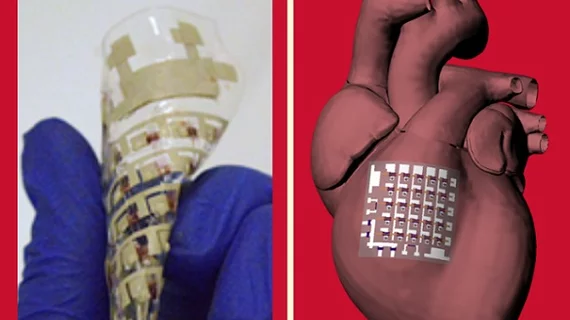New-look implantable device can identify, treat heart disease
Researchers have developed a new implantable device that can be placed directly on the heart to gather valuable data and even treat heart disease, sharing their progress in Nature Electronics.
“The ideal device should possess cardiac-tissue-like mechanical softness and deformability, and be able to perform spatiotemporal mapping of cardiac conduction characteristics and other physical parameters,” wrote lead author Kyoseung Sim, PhD, of the University of Houston, and colleagues. “However, existing patches constructed from rigid materials with structurally engineered mechanical stretchability still have a hard–soft interface with the epicardium, which can strain cardiac tissue and does not allow for deformation with a beating heart. Alternatively, patches made from intrinsically soft materials lack spatiotemporal mapping or sensing capabilities.”
The team’s device comes in the form of a patch made from “fully rubbery electronics.” It is able to gather a person’s electrophysiological data, temperature, heartbeat and more.
“For people who have heart arrhythmia or a heart attack, you need to quickly identify the problem,” corresponding author Cunjiang Yu, PhD, an associate professor at the University of Houston, said in a prepared statement. “This device can do that.”
Another key feature of this new device, the researchers explained, is that it was designed to harvest energy from each heartbeat. This means it can function without an external power source and even provide “therapeutic benefits” such as thermal ablation.
In the same statement, Yu added that this research “suggests a promising route toward next-generational bioelectronics and biosensors that do not have a hard–soft interface for the heart and other organs.”
Click here for the full analysis from Nature Electronics.

